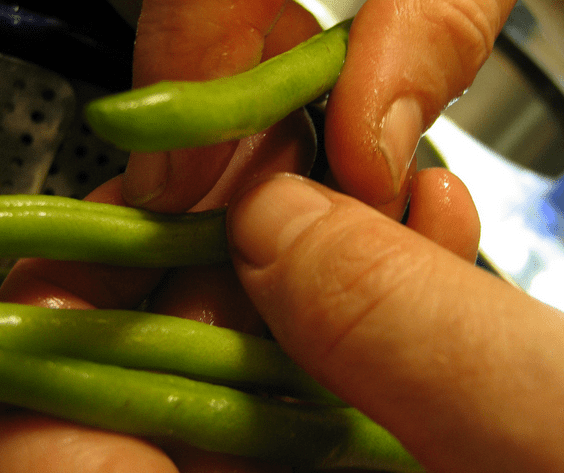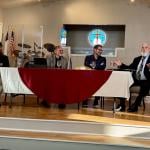There was a time that picking green beans in my grandparent’s garden and sitting on the front porch snapping off the stems was a spiritual practice for me. There was a sense of community with my Grandparents as they would tell stories, sing songs (often church hymns) and teach me practical life skills like preparing, cooking and eating bacon dressed green beans. Then flash forward thirty-some years and my own mind reels at the transformation of culture and community with the impact of technology. Carol Howard Merritt’s own stories of her childhood shucking corn through to her present day account of sharing a family moment watching You tube video of the film ‘Helen Keller”, mirrors my own experience from snapping beans to the reality of attending seminary in a partially online capacity. Technology and our connection to so much information – has changed the way we live, work, go to school and build groups of community. What some think are amazing gifts of connection, others finds disorienting and chaotic.
In recent conversations concerning best practices for churches and staff in regard to the use of social media the opinions ranged from, “The internet is making people more stupid. They (people) know lots of information about an inch deep and a mile wide.” This criticism of social media as a form of community was then met with individuals retelling of stories of how connections via social media were grounds for sincere experiences of faith and community that were as important to the individual as face-to-face interactions within a traditional faith community setting.
Each person was entitled to an opinion concerning social media, but the idea that it is a passing fad or unnecessary for the “Church” to engage in – in positive ways – is shortsighted. In recent reading, discussion and writing in a course concerning the emerging movements of the Church there were many discoveries concerning changes concerning faith as we know it. Bass lists the guideline specific to the pattern of awakening through the bumpy stages of: ‘breakdown and decline, imagination and possibility, unfolding of a new vision and transformation/reformation of institutions. (Bass, 33-34).’
Life has significantly changed since I was a small child snapping beans and Carol was shucking corn. The awakening is well underway, and the church (even if it would rather bury its head in the proverbial sand) is already moving in the wake of its ebb and flow. The way in which people tell stories has changed. While I feel there is still a need for face-to-face communication, the new ways people communicate still are valuable venues for connection and community. As the church moves from imagining new visions to reformation of current institutions, it is necessary to grow in our abilities to tell God and our stories in the new space and place where communities gather. Merritt helps to understand this shift from three different perspectives: cultural, philosophical, and faith.
Just as the technology of the printing press changed Martin Luther’s world over 500 years ago, technology and cultural information is more widely available to more people than ever before. By the means of the internet and social media mediums, information and culture is globally available to the masses. The availability of this information combined with a Philosophical framework of postmodern perspective does make it difficult for people to define a single “Story” to ascribe to and believe in. Historical examples of conflict and wars have made people, “…skeptical of that grand story that promised a better future for each generation.” (Merritt, 65)
This philosophically varied atmosphere causes people to feel it only wise to consider all perspectives. This market of philosophical choice partnered with a continued need to tell and hear stories helps people to build, “…short status reports…full of emotion and wisdom and they can be a place where we account for the good news in our own particularities.” (Merritt, 65)
In the midst of historical or present bad news, this wide philosophical market allows for the individual to tell good news developed with the support of many philosophical resources. This reality offers people of faith the opportunities to engage with and respond to questions like, “If there is no universal truth, then what we are saying about God?” (Merritt, 66)
It is in the midst of caring conversations, authentic community and Christians willing to wrestle with these big questions where they…
…realize that there is something sacred, not just in the Story, but also in our stories. In silence, with prayer, and through our liturgies, we worship together. We explore the ways in which God is present in our spiritual journeys, we look back and see how God aided us in our decisions, or how certain people reflected the hands and feet of Christ in our lives. (Merritt, 67)
This kind of open-ended communication (in real time as well as online) allow communities to engage in life together, acknowledging God’s presence and the Holy Spirit’s work in, “…our broken bits together, listening to one another, and caring for one another.” (Merritt, 68)
There are practical skills of surfing the waves of change in this awakening that Bass points out: Prepare for the awakening by reading the Bible as you’ve never laid eyes on it before. Engage in two new faith practices (internal/external). Have fun. Participate in making a change. (Bass. 265-266)
If the church is to emerge out of this time of awakening, it is paramount to use storytelling tools and gain a better understanding of the postmodern world. But one of the most powerful stories that we can tell is the one of God’s ongoing presence, love and care of and for humanity. It is in our stories of brokenness and need that God’s story emerges to comfort and woo the hearts of humanity into a community – a relationship – with him and the Church. Psalm 11 entitled the “Song of Trust in God” depicts the reader like a panic-filled bird flitting from place to place not able to find a resting place. She witnesses arrows, darkness and crumbling foundations. The Psalmist then states, “What can the righteous do?” (vs.3) and response is this, “the Lord is in the temple, in heaven, and sees all of humanity. The Lord tests the righteous and the wicked and his soul hates to lover of violence.” (Vs. 4-5) The Psalm ends with reassurance that the Lord is “righteous”, “loves righteous deeds” and “the upright shall behold his face.” (Vs. 7)
In times of change, we tend to panic and flit about like the bird in this Psalm. But God sees where we are walking and walks with us on this journey of awakening. What can we do in this time of awakening? We can tell our stories and God’s Story. We can listen to others and reach out to build atmospheres of community. We can stand against the violence we see and be a means of reassurance by sharing ways we have experienced the presence of God in all circumstances. God not only wants the Church to behold his face – but all of humanity. This kind of awakening is not without its challenges, but in our brokenness and sincere attempts to use tools for awakening, God can create and story that displays a mosaic of faith that will stand the test and changes of all time.
From sitting on my grandparents porch snapping green beans, to Helen Keller videos, online education and telling our stories – communication is the goal.
How we communicate may vary, but the message of God’s story is one that we need to faithfully and creatively continue to share – in all the mediums and forms we have been given.
—












